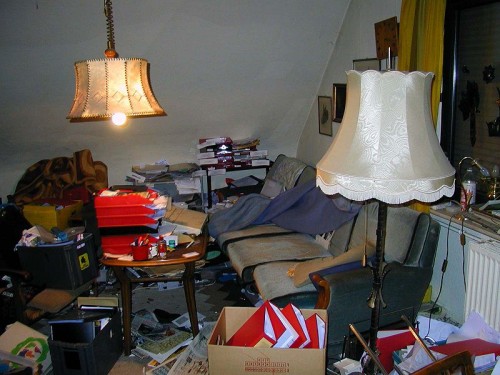Hoarding and other disorders – are they rooted in the mind or the market? And what does this tell us about mental illness?
 Of late, behaviors such as hoarding are getting a lot of attention. TV shows devoted to the tormented lives of hoarders have hit the scene and certainly, an increase in interest among mental health professionals and the media has surfaced. There are several substantive sociological issues here that go beyond the psychological elements and individual consequences of hoarding behavior – or buying, spending, drinking, gambling – all of which are considered by the American Psychiatric Association to be disorders in and of themselves or at least symptomatic of other disorders such as anxiety or bipolar disorder. Compulsive buying is another example. While not considered to be a disorder of its own, compulsive buying is being considered as such for the new version of DSM to be released in 2013 and is already listed as a symptom of Bipolar disorder. Jennifer Hemler, for instance, in her forthcoming paper, “The Medicalization of Compulsive Shopping: a Sociological Disorder in the Making,” describes how compulsive buying is rooted in much more than psychological disorder or an imbalance of brain chemicals.
Of late, behaviors such as hoarding are getting a lot of attention. TV shows devoted to the tormented lives of hoarders have hit the scene and certainly, an increase in interest among mental health professionals and the media has surfaced. There are several substantive sociological issues here that go beyond the psychological elements and individual consequences of hoarding behavior – or buying, spending, drinking, gambling – all of which are considered by the American Psychiatric Association to be disorders in and of themselves or at least symptomatic of other disorders such as anxiety or bipolar disorder. Compulsive buying is another example. While not considered to be a disorder of its own, compulsive buying is being considered as such for the new version of DSM to be released in 2013 and is already listed as a symptom of Bipolar disorder. Jennifer Hemler, for instance, in her forthcoming paper, “The Medicalization of Compulsive Shopping: a Sociological Disorder in the Making,” describes how compulsive buying is rooted in much more than psychological disorder or an imbalance of brain chemicals.
If you’ve ever experienced a hoarding home, you know it can be unsettling and even disturbing and that the consequences to people’s social lives and sense of self and even physical health can be disastrous. While it is important to know about hoarding as an experience, it is crucial for sociologists a nd other social scientists to focus, in addition, on several questions: When does one become a so-called hoarder – i.e. what’s the line between messy and hoarding? Another question of importance is whether hoarding should be considered a symptom or consequence of anxiety, as the article below from NPR suggests. Or, is it really the other end of the spectrum from something like Obsessive Compulsive Disorder, an anxiety disorder? And finally, the subject of my inquiry today: when we’re talking about disorders like hoarding or compulsive buying, another disorder involving the collecting of items, usually superfluously, are these not possibly disorders that could only take place in a society that so compels us to want stuff and to buy things? Might the presence of stuff as a comfort – whether it be new items stored in closets, never to be worn or used, or surrounding oneself with used, broken, generally useless items to the point that there is barely any empty space – much more likely be a result of the anxiety about having things, buying things and possessing things that is so central to our consumer society.
nd other social scientists to focus, in addition, on several questions: When does one become a so-called hoarder – i.e. what’s the line between messy and hoarding? Another question of importance is whether hoarding should be considered a symptom or consequence of anxiety, as the article below from NPR suggests. Or, is it really the other end of the spectrum from something like Obsessive Compulsive Disorder, an anxiety disorder? And finally, the subject of my inquiry today: when we’re talking about disorders like hoarding or compulsive buying, another disorder involving the collecting of items, usually superfluously, are these not possibly disorders that could only take place in a society that so compels us to want stuff and to buy things? Might the presence of stuff as a comfort – whether it be new items stored in closets, never to be worn or used, or surrounding oneself with used, broken, generally useless items to the point that there is barely any empty space – much more likely be a result of the anxiety about having things, buying things and possessing things that is so central to our consumer society.
As Americans, we push people to want things, expensive items – cars, houses, clothes, electronics. The majority of Americans are in debt because of their desire for and acquisition of items well beyond their means. Foreclosures are rampant because we live in houses with mortgages beyond our reach. Most of our children have gadgets that are each more expensive than our cumulative property at their age. And while most of us do not hoard items to the point where we can barely live in our homes, barely move about our space freely, it certainly makes sociological sense (as well as good common sense) to at least consider the context in which these “disorders” arise. If we do so, we might question if these behaviors are not closer to a normal response to particular social stimuli than mental disorders. Surely, I will not argue that there may also be psychological mechanisms implicated here, but to classify this type of behavior, that could only take place in a particular kind of society with a particular set of values, seems not only inaccurate, but potentially damaging (see the blog by Allan Horwitz, below).
For Hoarders, The Mess Begins in the Mind
![]() DSM V: Getting Closer Pathologizing Everyone by Allan Horwitz
DSM V: Getting Closer Pathologizing Everyone by Allan Horwitz





1728-4457/asset/PopulationCouncilLogo.jpg?v=1&s=03074651676b98d6b9d0ef1234bd48fe7ff937c3)
This is an interesting thought that I believe contains a lot of truth in it. Our society definitely has a significant impact on people’s aspirations, which thus affects the way one behaves. Similar to hoarding and compulsive buying are eating disorders, which has become a fairly recent diagnosis. These disorders seem to surface because of shifting societal values. It was only until the desired body image was skinny or skinnier that eating disorders arose. The pressure to conform to an ideal creates much anxiety and has caused people to go to drastic lengths in pursuit of obtaining what society deems to be the best. It’s not enough that we feel the need to live our lives and conform to society’s supreme model, but we are constantly reminded of it through advertisements that tell you to buy this product, or images that tell you to look and dress a certain way. It’s no wonder that a plethora of new disorders are arising that never seemed to have existed before. While there are probably some psychological mechanisms at work that cause these disorders, I think a larger part of this problem stems from our societal values that impose specific beliefs on people. This may cause some to act in extreme ways that may be seen as deviant from societal norms and thus be labeled as new mental disorders or illnesses.
I definitely agree with the author’s point here that in a consumerist society, such as the one found in America, hoarding is almost inevitable. I can say with absolute certainty that everyone has a friend that will regularly go out to a mall or a department store with a group of friends, especially when the group is under the age of 25, and buy nonessential items. I have spoken to a few of my own friends who do this and the common theme among the people that act this way is that someone else did it first so they felt they had to join in. It was not so much that they felt pressured into buying it by their peers, but I believe it was more of a societal pressure stemming from being in a store where nearly everyone is purchasing something. I have also fallen victim to this; just a month or two ago I went out to a mall and purchased a shirt that I did not need, simply because it was on sale and that I felt as though “I may need it one day.” I think a large portion of hoarding clothing comes from this security, for both guys and girls. When looks and first impressions are such a pivotal aspect of society now, it is increasingly important to have a wardrobe that is versatile enough for any situation. So even though I bought a shirt that I may never end up wearing, just knowing that I have a shirt in that color is enough security for me because if I ever *do* need it, it is there for me.